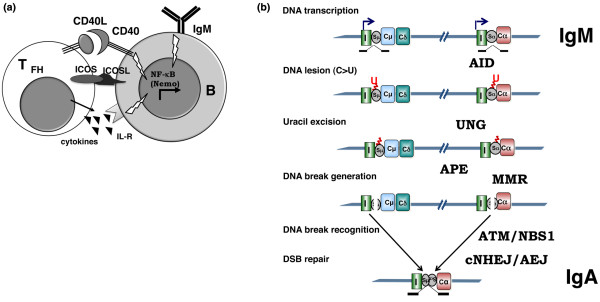Figure 1.

Schematic representation of class-switch recombination in germinal center. (a) T cell-B cell cooperation in immunoglobulin class-switch recombination (Ig-CSR). Impaired function of CD40 and CD40L (CD40 ligand) and, to a lesser extent, inducible co-stimulator (ICOS) and nuclear factor-kappa-B (NF-κB) essential modulator (NEMO) results in class-switch recombination deficiency (CSR-D). B, B cell; IL-R, interleukin receptor; TFH, T follicular helper. (b) Schematic representation of Ig-CSR. Only part of the IgH locus with I (I exon), S (switch region), and C (constant region) is depicted. The intermediate steps of CSR are shown on the left. Impaired function of activation-induced cytidine deaminase (AID), uracil-N-glycosylase (UNG), mismatch repair (MMR), ataxia telangiectasia mutated (ATM), Nijmegen breakage syndrome (NBS1), and conventional non-homologous end joining (cNHEJ) results in variable CSR-D. AEJ, alternative end joining; APE, AP endonuclease; DSB, double-stranded DNA break; U, uracil.
